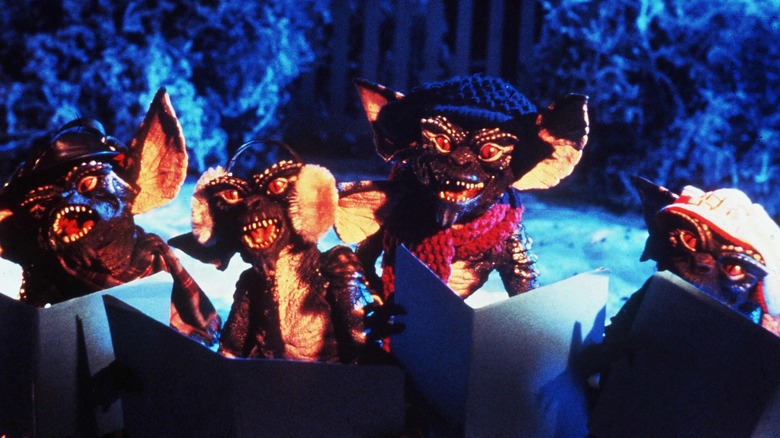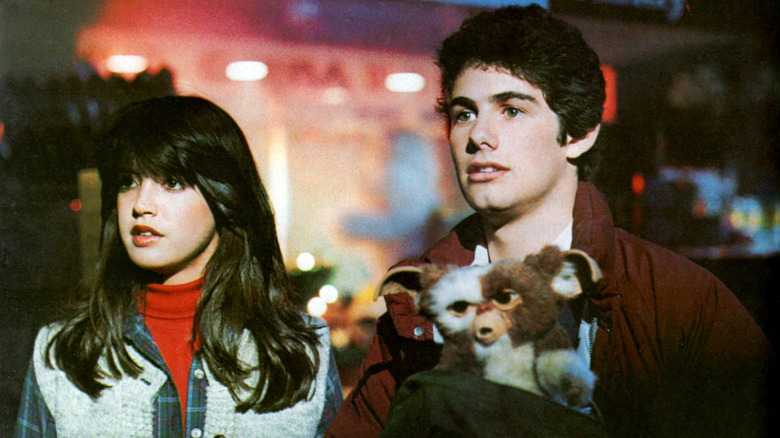How Gremlins' Infamous Christmas Story Managed To Make It Into The Film
There is one scene from "Gremlins" that has always stood out to me and I think about it every Christmas. Phoebe Cates' character Kate has a monologue about how much she hates Christmas because, as a child, her father went missing and the police discovered him with a broken neck inside her chimney while dressed as Santa Claus with an armful of presents. "And that's how I found out there was no Santa Claus," she grimly declares at the end in a flat voice.
Kate's speech about this tragic holiday death paints a visceral image in your mind. It captures the essence of "Gremlins" which, on the surface, is a family-friendly, yuletide comedy with a dark and freaky center. This duality mirrors the Gremlins themselves: the cute, cuddly Gizmo on the outside and the mischievous monster within.
In an interview with Yahoo!, screenwriter Christopher Columbus reveals that this blend of darkness and light is what intrigued him the most about the story:
"I'm fascinated by Christmas is the time of year when people are at their most emotional and happiest, yet there's a whole other side of the population that's incredibly depressed, potentially out of work, particularly this year. So you take that, and you set it against the backdrop of back in the day something like 'Gremlins.' And that's an interesting stew to me. When people should be celebrating with their families, these ridiculously evil monsters are terrorizing the town and killing everyone. That is fascinating."
But Warner Bros. was uncomfortable with the monologue about a dead Santa Claus and wanted to remove it from the film because it was too macabre.
Joe Dante and Steven Spielberg fought to keep it
Despite the studio wanting to cut the scene, director Joe Dante, alongside producer Steven Spielberg, vehemently opposed its removal because it was Dante's favorite part of the film. It was also Christopher Columbus' favorite moment in "Gremlins," but as the screenwriter he had less sway in the decision-making process. According to Columbus in his Yahoo! interview, it took Spielberg and Dante's stature and rallying for the scene's importance to persuade Warner Bros. to keep the speech.
The Christmas story had drawn controversy before. Columbus clarifies to Yahoo! that the monologue was not taken from an urban legend, as one might initially believe. Instead, it was inspired by Gahan Wilson's cartoon from Playboy in 1964 (via The Washington Post). The cartoon depicts a chimney worker informing a shocked middle-aged couple, "Well, we found out what's been clogging your chimney since last December, Miss Emmy." Santa Claus lies on the bottom, his belly no longer a bowl full of jelly but brittle bones, causing his red suit to melt into the ground. His skeletal face is slack-jawed and has hollow, black eye sockets. It's an incredibly eerie image. Wilson had told The Washington Post he received "more angry mail than anything I ever did. You can mess around with religion, but when you kill off Santa Claus, there's an uproar. You never know."
Even when only spoken of in "Gremlins," the gruesome Christmas tragedy has a devastating impact. But despite how unsettling it is, the scene carries a meaningful message that the holiday season does not always have to be joyous and is often a profoundly painful time for so many people. Without this scene, "Gremlins" might not have left as lasting an impression as a truly twisted and offbeat Christmas movie.

